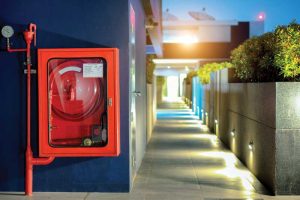
By Amy Schmidt and Eric W. Banks
Designers, specifiers, and code officials are unfamiliar with the best ways to locate information regarding National Fire Protection Association (NFPA) 285 test data and tested assemblies. This article provides guidance on how and where to find compliant tested assemblies and the extension of test data through engineering analyses.
Since its inaugural edition in 2000, the International Building Code (IBC) has included requirements that certain exterior walls and exterior wall coverings shall be tested and comply with NFPA 285, Standard Fire Test Method for Evaluation of Fire Propagation Characteristics of Exterior Wall Assemblies Containing Combustible Components. Since then, both the IBC requirements and the test standard itself have continued to evolve to increase stringency, clarity, and enforceability. Changes to the 2024 Edition of the IBC help clarify compliance methods for exterior wall assemblies required to be tested and comply with NFPA 285.
Important fire performance data
NFPA 285 test specimens are highly instrumented to record temperature data at a series of specific locations within each layer of the wall assembly and throughout the duration of the test. Depending on configuration, it is not uncommon for tests of modern exterior wall assemblies to collect data from 66, 80, or even more thermocouples.
The data collected provides manufacturers and fire experts the ability to assess how the overall wall assembly, the individual layers, and major components of the assembly behave when exposed to a prescribed fire scenario. This scenario includes a fire that starts on the interior of the building and propagates to the exterior facade. It measures the assembly’s ability to minimize the spread of fire from floor to floor and vertically and horizontally across the exterior of the building.
To many manufacturers and fire experts, the value of NFPA 285 tests is as much about the lessons learned, and fire behavior observed as it is a pass/fail test result.




